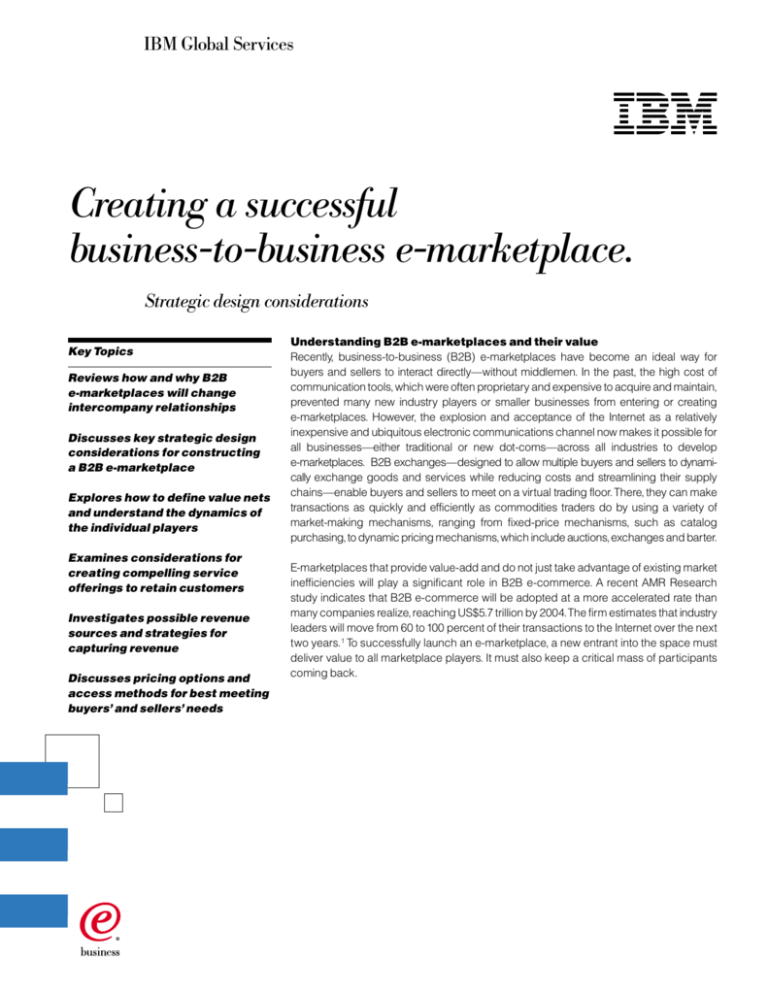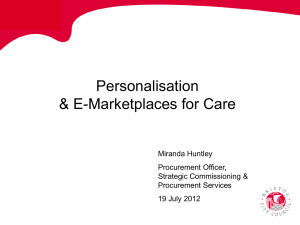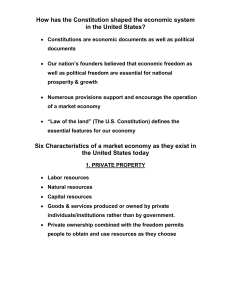
IBM Global Services
Creating a successful
business-to-business e-marketplace.
Strategic design considerations
Key Topics
Reviews how and why B2B
e-marketplaces will change
intercompany relationships
Discusses key strategic design
considerations for constructing
a B2B e-marketplace
Explores how to define value nets
and understand the dynamics of
the individual players
Examines considerations for
creating compelling service
offerings to retain customers
Investigates possible revenue
sources and strategies for
capturing revenue
Discusses pricing options and
access methods for best meeting
buyers’ and sellers’ needs
Understanding B2B e-marketplaces and their value
Recently, business-to-business (B2B) e-marketplaces have become an ideal way for
buyers and sellers to interact directly—without middlemen. In the past, the high cost of
communication tools, which were often proprietary and expensive to acquire and maintain,
prevented many new industry players or smaller businesses from entering or creating
e-marketplaces. However, the explosion and acceptance of the Internet as a relatively
inexpensive and ubiquitous electronic communications channel now makes it possible for
all businesses—either traditional or new dot-coms—across all industries to develop
e-marketplaces. B2B exchanges—designed to allow multiple buyers and sellers to dynamically exchange goods and services while reducing costs and streamlining their supply
chains—enable buyers and sellers to meet on a virtual trading floor. There, they can make
transactions as quickly and efficiently as commodities traders do by using a variety of
market-making mechanisms, ranging from fixed-price mechanisms, such as catalog
purchasing, to dynamic pricing mechanisms, which include auctions, exchanges and barter.
E-marketplaces that provide value-add and do not just take advantage of existing market
inefficiencies will play a significant role in B2B e-commerce. A recent AMR Research
study indicates that B2B e-commerce will be adopted at a more accelerated rate than
many companies realize, reaching US$5.7 trillion by 2004. The firm estimates that industry
leaders will move from 60 to 100 percent of their transactions to the Internet over the next
two years.1 To successfully launch an e-marketplace, a new entrant into the space must
deliver value to all marketplace players. It must also keep a critical mass of participants
coming back.
A well-defined business plan is imperative. And in defining a business plan, new entrants
must understand that the rules have changed. One-time competitors—such as industry
incumbents—are now potential partners. For example, e-STEEL, a startup B2B steel
exchange, has formed alliances with U.S. Steel Group and Macsteel Service Centers USA.
Furthermore, the dynamics of an e-marketplace call for an evolving strategy. During the
initial phase, designed to attract key players to the e-marketplace, the focus may be on
rapid growth of membership and transactions necessary to achieve the critical mass
needed to sustain the e-marketplace. The final phase must consider how to maintain and
increase the number of participants by offering unique, value-added services.
Before implementing an e-marketplace, firms must consider the following questions:
• Audience—Who are the players in the e-marketplace?
• Offering—What does the e-marketplace offer these players?
• Revenue source—How does the e-marketplace owner capture value from the marketplace and from whom?
• Pricing mechanism—How are prices determined for items being bought and sold?
• Access—What e-marketplace access restrictions are in place?
• Control—Who has strategic and tactical control over the rules and regulations of the
e-marketplace?
Defining a value net and understanding the roles of different
e-marketplace players
One of the first questions an e-marketplace developer should ask is, “Whom do we
serve? What market segments and subsegments do we address?” A developer can
begin to address these questions by constructing a value net for the e-marketplace. The
five key constituencies in the value net, who impact any marketplace, include:
• Competing marketplaces
• Sellers
• Buyers
• Transaction influencers
• Service providers.
2
Although sellers and buyers are the primary players in the e-marketplace, others cannot
be ignored. Most established industries already have an associated marketplace, or
another means by which buyers and sellers find each other. A successful e-marketplace
will provide compelling offerings that differentiate it from incumbent competitors as well
as other potential e-marketplaces.
One source of differentiation can be made through using value-added services to match
buyers’ and sellers’ needs and complete transactions between the two. Examples
include provisioning information, logistics, order tracking, insurance and financing.
E-marketplace designers must identify key services and decide whether to offer some or
all of them themselves, or to develop alliances with service providers.
Transaction influencers help increase liquidity in the e-marketplace by inducing transactions
between buyers and sellers. In financial markets, for instance, business news providers
such as Reuters and Bloomberg perform an advisory role. The information they provide
allows buyers and sellers to reevaluate their stock positions and make trades. In B2B
markets, influencers often reside within buyer or seller organizations. Buyers’ customers
may also be key influencers. Identifying influencers and providing for their potential
(or future) participation are important aspects of e-marketplace strategy.
Once players in the e-marketplace value net are named, the dynamics between them
must be understood. To do this, players can be grouped into three key categories:
• Core-mass players—The primary, value-delivering player in the market. In stock markets,
they are buyers and sellers of stock. The correct blend of core mass contains enough
buyers and sellers to create liquidity in an e-marketplace.
• Mass attractors—Marquee players who pull a core mass of buyers and sellers into the
marketplace. In a stock market, those might be well-known, blue-chip companies whose
brand-name stocks attract new traders. Large buyers and sellers in an industry will be the
mass attractors because of their transaction volumes.
• Mass followers—Noncore mass buyers and sellers who join the marketplace once trading
has begun, and who are attracted either by liquidity or number of players in the market.
3
Categorizing players in this manner helps determine where to focus marketing
efforts during the phases of e-marketplace development. At the startup phase, the
e-marketplace could adopt the strategy of seeking out and soliciting the mass attractors
by offering compelling value propositions. Subsequently, the focus could shift to retaining
the core mass and using its strength to retain mass attractors. Critical mass is attained
when mass followers begin flocking to the e-marketplace because of the number of
core-mass players and the consequent liquidity created in the marketplace. They then
become part of the core mass and contribute to increasing marketplace liquidity.
When identifying players in the value net, companies must be aware of different roles
within an organization. For example, Chemdex, an e-marketplace for the life sciences
industry, has to attract not only scientists who make the original purchasing decision but
also purchasing personnel from the buyer organization. It must offer value propositions
that appeal to both parties within the organization.
Other e-marketplaces may start by attracting a key buyer, who then attracts a core mass
of sellers, who can in turn attract other buyers. Ford and General Motors started their
e-marketplace in this way—a strategy that makes sense in the auto industry, which
includes only a few key buyers (auto manufacturers) and a large number of suppliers.
Other e-marketplaces may first attempt to attract well-known sellers who would be of
interest to a core mass of buyers.
Another strategy is for the e-marketplace operator to attract the core mass first, with an
initial value-added offering related to market transactions such as information. Consumer
portals such as Yahoo! leverage their massive site traffic to attract merchants to their
e-commerce sites. Another approach to achieving critical mass is to convince traditional
brokers/middlemen to be the first to join an e-marketplace. They may do so if they see the
potential for cutting transaction costs and time. For example, one of the equity owners of
MetalSite, a steel e-marketplace, is Ryerson Tull, the largest steel distributor or “service
center” in the industry. Ryerson is confident that its role on MetalSite adds value in the
steel industry and has invited 60,000 of its own customers to participate in MetalSite.
Service providers are also a key audience in the value net. The e-marketplace may profit
from establishing an exclusive partnership with a service provider. For example, in
a marketplace for perishables such as flowers and food, transportation is a key service.
Floraplex, a floral e-marketplace, and FoodUSA, a food and beverages e-marketplace,
are forming alliances with refrigerated transportation providers. Exclusive partnerships
may prove to be a significant hurdle for the e-marketplace if buyers and sellers have
to pay a higher price for a service they can find for themselves. For that reason, an
e-marketplace may choose to ally with another e-marketplace for a related service.
4
Staples—Improving customer
service and reducing costs
Challenge
Staples had already launched a
business-to-business online solution
and was experiencing a demand
exceeding its capacity. Staples
needed a more scalable solution
with an integrated back-end.
Solution
Staples uses IBM software,
servers and services to process
online ordering and payment from
its large corporate customer site.
Benefits
Today, Staples’ B2B customers
enjoy a more efficient purchasing
channel, and Staples has reduced
order-processing costs.
The decision to develop an exclusive or open relationship with service providers
depends on the direct recipient of the service. If the e-marketplace operator receives
the service, it may form an exclusive supplier relationship subject to periodic review.
However, if the e-marketplace traders are the direct recipients of service—for
example, obtaining financing for a purchase—the e-marketplace operator may not
be in the best position to monitor the quality of the service. In those situations, a more
open relationship with multiple suppliers, perhaps through another e-marketplace,
could be a better approach.
Creating valuable service offerings to attract and maintain customers
The services and knowledge that an e-marketplace offers to its customers are missioncritical. Key questions firms should ask when designing a service strategy include the
following: “What are we offering? What value can this e-marketplace deliver to the
targeted audience?” When the e-marketplace is primarily a venue for buying and selling
products, adding services that facilitate the initiation and completion of a sales transaction
can be a differentiator against competitors and increase member loyalty. Examples of
such services include:
• Providing standardized and comparable information about products from multiple sellers
• Guaranteeing qualified business partners (for example, rating credit-worthy buyers and
suppliers who deliver as promised)
• Handling order and financial transactions online
• Splitting a single order from a buyer into orders for multiple suppliers
• Providing logistics services
• Maintaining inventory of high-demand products.
5
In markets such as the transportation industry—where meeting deadlines is critical—
and in industries where products are perishable, such as in the food industry, the
e-marketplace must not only match trading partners but also facilitate fast and efficient
transaction completions. In markets such as utility spot markets—where products are
generic, differentiation is less critical and availability is more important—an e-marketplace
should offer services that deal with trade volume and time needs by splitting or consolidating orders.
An e-marketplace can also mask transacting parties’ identities, making it possible for a
player who fears brand erosion to sell surplus or off-grade material without letting competitors or premium customers know about it in the open market. In all cases, e-marketplaces
have the opportunity to provide e-business-enabled information services that improve
existing manual processes by offering more detail in a timely, efficient manner while reducing
the cost of the transaction. These services can form the initial value propositions that attract
members to a new e-marketplace where liquidity has not yet been established.
When designing an e-marketplace, it is important to understand which services could
be a source of strategic control and to seek to perform those tasks directly. In the case
of Marshall Industries, a company that sells electronic parts to component assemblers,
providing knowledge, such as interactive training sessions and seminars, helps to keep
the e-marketplace from being disintermediated by parts manufacturers selling directly
to assemblers.
6
For long-term sustainability, an e-marketplace must offer services that become more
valuable to its users as more members participate. For example, eBay, the consumer-toconsumer e-marketplace, uses positive feedback loops to provide buyer and seller
ratings based on feedback from previous transactions that involved the buyer or seller.
The quality of sellers’ ratings improve as more transactions are executed, thereby
attracting more participants and, ultimately, increasing transaction numbers. Figure 1
summarizes the types of services described in this section.
Perform
transactions
Gather and
analyze
transaction
data
Services to
induce
transactions
Attract/retain
members
Services to
attract/retain
members
Figure 1: Positioning services to aid in the primary e-marketplace activities of attracting and
retaining members and performing transactions
7
Capturing revenue—sources and strategic considerations
Revenue sources may be one or more of the players in the e-marketplace value net. Third
parties who have interests in selling high-value products or services in conjunction with
the original transaction can also be a revenue source.
A firm can capture value in the form of immediate or future revenue. An e-marketplace
designer may choose to defer capturing revenue in favor of developing a critical mass of
traders and transactions. Proxies for potential future revenue include the:
• Number of members (both sellers and buyers)
• Transaction volume
• Number of product types
• Scope for expansion into related industries
• Scope for vertical integration
• Number of Web site page views.
Immediate revenue sources derived from matching buyers and sellers are the spread
(the price difference between the buying and selling price), percentage of sales and
fixed transaction fees. Firms may also charge listing and membership fees (one-time or
ongoing). Other revenue sources arise from providing services that complement
transactions. Firms that mediate the financial transaction, for instance, may make money
on the float. The firm may also receive commissions or referral fees from service providers
who receive business from the e-marketplace. Finally, advertising revenue, the mainstay
of consumer portals, can also be an added source of income in the e-marketplace.
However, to keep customers satisfied, e-marketplaces must remain focused on efficient
and fast online transactions—rather than increasing page views per visitor to maximize
advertising revenue.
When an e-marketplace receives revenue only after the completion of a transaction, it is
signaling to members that it will try to make the market as liquid as possible. This can be
an important value proposition for members, who have little to lose even if they do not end
up transacting in the e-marketplace and in industries where the conventional marketplace is not very liquid.
8
If revenue is a percentage of sales, buyers may consider it to be in the e-marketplace’s
interest to execute a sale at the highest possible price and therefore expect the market to
cater more to sellers’ interests. If the e-marketplace cost to execute a transaction is
independent of the sales amount, the better option may be to make revenue from a price
difference or a fixed transaction fee.
An e-marketplace can or may charge membership fees when the financial benefit
to members is well established. If members pay a fixed membership fee, the task of
inducing transactions shifts from the e-marketplace to members, who will use the marketplace as often as possible to justify the cost. One-time membership or setup fees may be
charged when there is an incremental cost to the e-marketplace for each new member,
as in the case of National Transportation Exchange (NTE), where training and software
integration costs are incurred when a new member joins.
Determining a pricing mechanism based on buyers’ and sellers’ needs
One of the key characteristics of an e-marketplace is the manner in which the sales price
is determined. The options for setting the price of transactions between a seller and a
buyer in the e-marketplace are:
Posted prices—Openly posted in a catalog and do not vary as a function of individual
trades.
Negotiated prices—Suitable when sellers may not want to expose their inventory to everyone in the market. Buyers and sellers communicate privately to agree on a price, taking advantage of the communication efficiencies of the online medium.
Auctions (straight, reverse or double)—With auctions, generating liquidity by attracting
buyers becomes the responsibility of the e-marketplace. There are several types of
auctions, including:
9
• Straight auction: Appropriate when a product has different values to different parties,
or when a product is perishable and needs to be moved quickly.
•
Reverse auction: Gives the seller with the most attractive offer the opportunity to meet a
buyer’s demand. Works best when a surplus of the product is available and when the
product from different suppliers is indistinguishable.
• Exchange or double auction: Used to determine volatile commodity prices. Suitable
when numerous buyers and sellers are simultaneously interested in purchasing and
selling commodity items. Price, the only differentiator, is determined by matching
received bids and offers.
Table 1 summarizes the influence of various industry and product characteristics on
the price-setting mechanism used.
Table 1: Industry and product characteristics that influence the price-setting mechanism
Pricing
mechanism
Industry
characteristics
Product
characteristics
e-marketplace
responsibilities
Posted
price
• Demand and supply
does not vary
unexpectedly
• Competition on
brand name and
features
• Aggregate catalog from
mutiple vendors
• Provide multisupplier product
comparisons (by feature)
• Prices too low to
justify negotiation
Negotiated
price
• Terms and
conditions open
to negotiations
• Price differentiation
• Nonstandard
products
• Prices high enough
to justify negotiation
• Security-enhanced electronic
communication channel for
members
• Workflow tools
Auction
• Products valued
differently by
different buyers
• Surplus items
• Create liquidity: attract large
numbers of buyers for items
to be auctioned
Exchange
(Double
auction)
10
• Both demand and
supply may vary
unpredictably
• Must be sold by
a deadline
• Commodity items
• Create liquidity: attract both
buyers and sellers
• Neutral to both parties
Whirlpool—Cutting
per-order costs
Challenge
Whirlpool wanted to improve
process efficiency for its trading
partners and reduce costs
through the use of an
e-marketplace.
Solution
IBM designed and built
Whirlpool’s trading partner portal,
an e-marketplace that allows
appliance dealers to manage
orders and inventory online.
Benefits
Whirlpool generated US$100
million in revenue in the first three
months of operations and gained
a 100 percent return on investment
in eight months.
e-marketplace access—determining the participant
The e-marketplace can control who has access to its site and build desirable traffic
through screenings or customized service offerings. Open access allows anyone with
Internet access to participate in the e-marketplace, an option that is generally acceptable
if the transaction values for the e-marketplace will be low, or if prior screening is not
expected. Open access also opens doors to competitors and e-marketplace substitutes,
and has the potential to diminish the impact of a firm’s agenda. In cases where the value
of goods is high or where the e-marketplace brand name is tightly coupled with that of its
participants, screening may be needed to address trust concerns. In such cases,
restricted access is necessary.
Another possibility is to have an e-marketplace with open access at the entry level but with
additional access control for more advanced levels, managed by each e-marketplace
player for each transaction. Such control enables participants to choose with whom they
interact, and to customize each transaction.
Defining whose interests take priority in the e-marketplace
In defining the e-marketplace control structure, it is important to ask whether one
player in the value net should control an e-marketplace. Whose interests take priority in a
transaction? Choices for control structure include seller controlled, neutral and buyer
controlled.2 Control may be active, where the controlling party is involved in marketplace’s
day-to-day operations, or passive, where governance is handed over to a third party. Both
buyers and sellers may receive benefits from biased e-marketplaces, as outlined in Table 2.
11
Table 2: Potential benefits to buyers and sellers in biased marketplaces
Control type
Benefits to buyers
Benefits to sellers
Buyer controlled
• Obtain best prices by aggregating
demand (from smaller buyers)
• Act as (outsourced) purchasing
agent
• Single point of access to a range
of complementary products
(across industries) that fulfill
a buyer need
• Ability to reach a large number
of buyers with lower sales
and marketing costs
• Qualified sales leads
Seller controlled
• Single point of access to a range of
complementary products from
an industry
• Single point of access to
comparable/competitive
products from multiple suppliers
• Ability to find buyers for off-grade or
surplus inventory
• Ability for smaller suppliers to
consolidate supply for large buyers
• Act as (outsourced) sales and
marketing agent
In fragmented and inefficient markets—where there are multiple search, transaction and
fulfillment activities—neutral e-marketplaces tend to capture significant value due to
their ability to unbundle and rebundle traditional activities. Such neutral marketplaces are
then free to form strategic alliances, without traditional roadblocks, and with a single
focus— thus optimizing submarkets.
When brand name, differentiation and key skills or knowledge are valued, seller
controlled e-marketplaces can be successful. However, achieving critical mass often
means sellers must engage in “co-opetition” with traditional competitors. In building an
e-marketplace, firms should reexamine relationships with traditional competitors to see
how they might achieve increased returns by redefining their relationships. An example
is MetalSite, an e-marketplace owned by a group of domestic steel producers and
service centers.
Buyer-controlled marketplaces, like GE TPN (Trading Process Network) Post, work well
when a major player already is conducting business and other players want to profit from
economies of scale. Such a structure not only reduces the cost of transaction for smaller
players but also cuts the cost of setting up an infrastructure and the time it takes to enter
an e-marketplace.
12
Conclusion
B2B e-marketplaces should be designed to challenge certain industry practices while
adopting new ones. Industry experts must be used in the design process to identify
which practices are considered problems by various segments in the industry. These
practices must be targeted with well-articulated value propositions developed in
advance as part of the strategy for, and design of, the e-marketplace. They must also
remain sensitive to industry norms and practices. Examples of industry problems that
have given rise to e-marketplaces are:
• Large-player-dominated industries that wish to reduce transaction costs (for example,
the Big Three automakers in the automotive industry)
• Fragmented industries with many small buyers and sellers where middlemen or distributors capture a large portion of the margin (for example, Chemdex in the life sciences
industry)
• Industries with unpredictable supply or demand, which require the liquidity of a large
marketplace and the ability to dynamically adjust prices based on supply and
demand (for example, MetalSite in the surplus and secondary steel industry)
• Industries where the product is a commodity with low margins (for example, NTE in the
road carrier industry)
• Industries where the products are perishable, requiring fast and efficient market
clearance and dynamic pricing that can change with time (for example, NTE in the road
carrier industry, or Floraplex in the flower industry).
The design choices that are made to address industry problems or adopt industry
practices will make or break an e-marketplace. Only a handful of e-marketplaces are
expected to survive in each industry. Consequently, a solid strategic design is critical to
attracting the members necessary to create interest and achieve momentum that will
encourage others to join an e-marketplace.
13
IBM Global Services is equipped to address all of your e-marketplace-related needs. As
a global leader in e-business services, software and servers, IBM Global Services can
team with your company to design, build and manage an e-marketplace on the cuttingedge of e-business.
Because e-business is the differentiator of success, e-business strategy development and
implementation will be critical for any business seeking to grow and remain competitive.
Using the skills and experience of the IBM e-business Strategy and Design Consulting
team, we can help you develop, implement and continually refine an e-business strategy to
help fuel growth and to differentiate your e-marketplace from competitors. IBM Global
Services has the people, infrastructure, partnerships and industry expertise to guide you
and grow with you as e-marketplaces evolve.
14
For more information
To learn more about IBM Global Services, visit:
ibm.com/services
The contents of this white paper are the result of ongoing collaboration between IBM
e-business Strategy and Design Consulting and the IBM T.J. Watson Research Center, a
relationship that further enables customers to stay on the cutting edge of e-business and
information technology. This white paper is a condensed version of Business-to-business
e-marketplaces: Strategic design considerations, written by Sugato Bagchi of the IBM
T.J. Watson Research Center and Anees Gopalani of IBM Global Services. To read the
original white paper in its entirety, visit:
ibm.com/services/insights
15
1
2
References
Jerry Bowles, Transform Your Business Through B2B e-commerce,
Forbes Partnership Programs.
Kenneth Berryman, Lorraine Harrington, Dennis Layton-Rodin and
Vincent Rerolle,“Current Research: Electronic commerce: Three emerging
strategies,” The McKinsey Quarterly, Number 1, 1998, pp. 152 - 159.
© Copyright IBM Corporation 2000
IBM Global Services
Route 100
Somers, NY 10589
U.S.A.
Produced in the United States of America
10-00
All Rights Reserved
IBM, the IBM logo and the e-business logo are
trademarks or registered trademarks of International
Business Machines Corporation in the United States,
other countries, or both.
Other company, product and service names may be
trademarks or service marks of others.
References in this publication to IBM products or
services do not imply that IBM intends to make them
available in all countries in which IBM operates.
G510-1754-00











